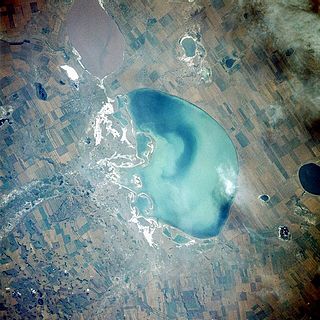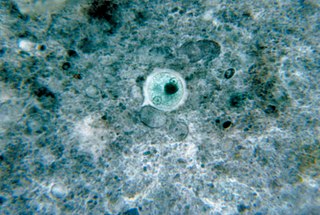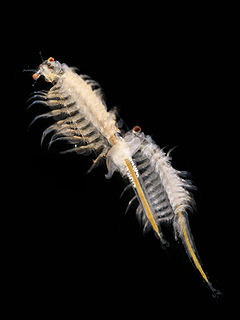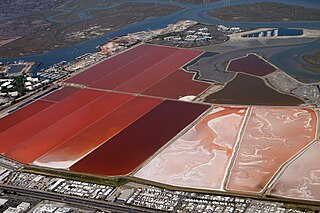Sea-Monkeys is a marketing term used to refer to brine shrimp (Artemia) that are sold as novelty aquarium pets. Developed in the United States in 1957 by Harold von Braunhut, they are sold as eggs intended to be added to water, and almost always come bundled in a kit of three pouches and instructions. Sometimes a small tank and/or supplementary pouches may also be included with the product. The product was heavily marketed in the 1960s and 70s, especially in comic books, and remains a presence in popular culture.

Artemia is a genus of aquatic crustaceans also known as brine shrimp. Artemia, the only genus in the family Artemiidae. The first historical record of the existence of Artemia dates back to the first half of the 10th century AD from Urmia Lake, Iran, with an example called by an Iranian geographer an "aquatic dog", although the first unambiguous record is the report and drawings made by Schlösser in 1757 of animals from Lymington, England. Artemia populations are found worldwide in inland saltwater lakes, but not in oceans. Artemia are able to avoid cohabiting with most types of predators, such as fish, by their ability to live in waters of very high salinity.

Mysida is an order of small, shrimp-like crustaceans in the malacostracan superorder Peracarida. Their common name opossum shrimps stems from the presence of a brood pouch or "marsupium" in females. The fact that the larvae are reared in this pouch and are not free-swimming characterises the order. The mysid's head bears a pair of stalked eyes and two pairs of antennae. The thorax consists of eight segments each bearing branching limbs, the whole concealed beneath a protective carapace and the abdomen has six segments and usually further small limbs.
Cryptobiosis or anabiosis is a metabolic state of life entered by an organism in response to adverse environmental conditions such as desiccation, freezing, and oxygen deficiency. In the cryptobiotic state, all measurable metabolic processes stop, preventing reproduction, development, and repair. When environmental conditions return to being hospitable, the organism will return to its metabolic state of life as it was prior to the cryptobiosis.

Lake Kulundinskoye is located on the southern edge of the much larger West Siberian Plain of south-central Russia. This lake, along with many other lakes in the region, exhibits a wide array of colors. The variations in color suggest that each lake is at a different stage of eutrophication. The lake immediately south of Lake Kulundinskoye is mauve-colored, contrasting with the oval, dark blue lake along the northwest edge of the photograph. Two deltas can be observed along the eastern side of Lake Kulundinskoye. The white areas are probably salty minerals that were deposited on the surface as water evaporated, since there are no outlets, rendering the water hypersaline, with a mineralization of 111.5 g/l, suitable for a native population of brine shrimp. A well-established shelter belt system runs generally north-south along the eastern side of Lake Kulundinskoye to form a manmade barrier to help protect against wind erosion. The cultivated field patterns are large and basically rectangular in shape.

A microbial cyst is a resting or dormant stage of a microorganism, usually a bacterium or a protist or rarely an invertebrate animal, that helps the organism to survive in unfavorable environmental conditions. It can be thought of as a state of suspended animation in which the metabolic processes of the cell are slowed and the cell ceases all activities like feeding and locomotion. Encystment, the formation of the cyst, also helps the microbe to disperse easily, from one host to another or to a more favorable environment. When the encysted microbe reaches an environment favorable to its growth and survival, the cyst wall breaks down by a process known as excystation. In excystment, the exact stimulus is unknown for most protists.

Artemia salina is a species of brine shrimp – aquatic crustaceans that are more closely related to Triops and cladocerans than to true shrimp. It belongs to a lineage that does not appear to have changed much in 100 million years.

Brine shrimp have the ability to produce dormant eggs, known as cysts. This has led to the extensive use of brine shrimp in aquaculture. The cysts may be stored for long periods and hatched on demand to provide a convenient form of live feed for larval fish and crustaceans.
Vibrio campbellii is a Gram-negative, curved rod-shaped, marine bacterium closely related to its sister species, Vibrio harveyi. It is an emerging pathogen in aquatic organisms.
Exiguobacterium is a genus of bacilli and a member of the low GC phyla of Bacillota. Collins et al. first described the genus Exiguobacterium with the characterization of E. aurantiacum strain DSM6208T from an alkaline potato processing plant. It has been found in areas covering a wide range of temperatures (-12 °C—55 °C) including glaciers in Greenland and hot springs in Yellowstone, and has been isolated from ancient permafrost in Siberia. This ability to survive in varying temperature extremes makes them an important area of study. Some strains in addition to dynamic thermal adaption are also halotolerant, can grow within a wide range of pH values (5-11), tolerate high levels of UV radiation, and heavy metal stress.

Artemia monica, the Mono Lake brine shrimp, is a species of brine shrimp, endemic to Mono Lake in California, United States.

Artemia franciscana is a species of brine shrimp endemic to the Americas but now widely introduced throughout the tropics and temperate zones worldwide.
Exiguobacterium aestuarii is a Gram-variable and rod-shaped bacterium from the genus of Exiguobacterium which has been isolated from tidal flat from the beach of Daepo in Korea.
Exiguobacterium alkaliphilum is a Gram-positive, rod-shaped, facultatively anaerobic and alkaliphilic bacterium from the genus of Exiguobacterium which has been isolated from alkaline wastewater drained sludge from New Delhi.
Exiguobacterium aquaticum is a Gram-positive, short rod-shaped and motile bacterium from the genus of Exiguobacterium which has been isolated from water from the Tikkar Tal Lake in Haryana.
Exiguobacterium enclense is a Gram-positive bacterium from the genus of Exiguobacterium which has been isolated from marine sediments from the Chorão island.
Exiguobacterium indicum is a Gram-positive, psychrophilic, non-spore-forming, alkaliphilic, rod-shaped and motile bacterium from the genus of Exiguobacterium which has been isolade from the Hamta glacier.
Exiguobacterium oxidotolerans is a Gram-positive, alkaliphilic, facultative anaerobic and motile bacterium from the genus of Exiguobacterium which has been isolated from a fish processing plant.
Exiguobacterium profundum is a Gram-positive, halotolerant, facultative anaerobic, moderately thermophilic and non-spore-forming bacterium from the genus of Exiguobacterium which has been isolade from a hydrothermal vent from the East Pacific Rise.
Exiguobacterium soli is a psychrophilic bacterium from the genus of Exiguobacterium which has been isolated from the McMurdo Dry Valleys.







